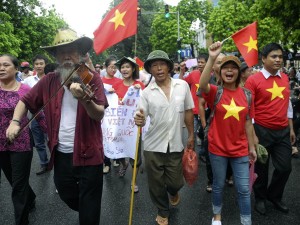China sends 4 ships to disputed area with Vietnam

About 200 protesters march through the capital’s streets on Sunday, July 1, 2012, in Hanoi Vietnam, following China's recent announcement that it will open nine oil and gas lots to international bidders, even though the area overlaps with Vietnam’s current foreign exploration contracts. The spat is the latest territorial dispute between Vietnam and China involving contested areas of the South China Sea believed rich in oil and natural gas reserves. (AP Photo/Margie Mason)
BEIJING—China has deployed four patrol ships to a disputed area of the West Philippine Sea (South China Sea), state media said on Sunday, amid a deepening row with Vietnam over competing territorial claims.
The ships, described by the Xinhua news agency as surveillance vessels, reached what China calls the Huayang reef in the Spratly islands on Sunday.
China last month summoned Vietnam’s ambassador in Beijing and protested a law adopted by the Vietnamese parliament that placed the disputed Spratly Islands under Hanoi’s sovereignty.
China and Vietnam, as well as other neighboring nations, are locked in long-standing territorial disputes over the West Philippine Sea, including the resources-rich Spratly and Paracel islands. Vietnam refers to the strategic waterway as the East Sea.
Xinhua said the ships left China’s southern island province of Hainan on June 26 and would travel more than 4,400 kilometers (2,400 nautical miles) on patrols.
Article continues after this advertisementThe ships are under the authority of the Chinese government’s State Oceanic Administration, not the Chinese Navy.
Article continues after this advertisementOn Thursday, China said it would resolutely oppose any military provocation in its territorial waters and protect its sovereignty—remarks that appeared to be directed partly at Vietnam.
China’s military has established routine naval patrols in the West Philippine Sea as a matter of “national sovereignty,” said Geng Yansheng, a defense ministry spokesperson.
“The determination and will of China’s military to safeguard national sovereignty and territorial integrity is unwavering,” Geng said.
Last month, Beijing elevated the administrative status of what it calls the Nansha (Spratly) and Xisha (Paracel) islands from a county to a prefectural-level district.
Rare Hanoi protest
China’s state-backed China National Offshore Oil Corp. (CNOOC) recently called for tenders from foreign companies to explore for oil in the West Philippine Sea near Vietnam, a move Hanoi deemed “illegal.”
CNOOC’s announcement sparked a rare street protest in Hanoi on Sunday.
About 200 Vietnamese marched through the capital’s streets chanting “Down with China!” in the rain. Some of the protesters waved flags and held up signs as they walked through central Hanoi toward the Chinese Embassy.
Police stopped traffic and did not attempt to quash the event, but the area near the embassy was cordoned off.
“We are very angry with China’s recent offer to look for oil inside Vietnam’s territory,” said Phuong Bich, 53, who was arrested three times last year during similar demonstrations that were broken up. “We urge the government to take action.”
Hanoi says the exploration area identified by CNOOC lies within Vietnam’s 375-kilometer (200-nautical mile) exclusive economic zone.
State-owned PetroVietnam has encouraged foreign companies to ignore China’s offer and says it will continue working on contracts signed with America’s ExxonMobil, Russia’s Gazprom, India’s ONGC and PetroVietnam affiliate PVEP.
Rhetoric between the two communist neighbors has become increasingly hostile in recent weeks.
Beijing’s defense ministry recently said it had “battle-ready” patrols protecting its interests in the area and warned Vietnam to back off its reported aerial patrols of the disputed Spratly Islands.
Tensions in the West Philippine Sea also have risen sharply recently, with China and the Philippines locked in a maritime dispute over Scarborough Shoal, a reef so close to the Philippine coast.
The Philippines, Vietnam, Brunei, Taiwan and Malaysia have staked territorial claims in the West Philippine Sea. China has claimed the entire strategic waterway as Chinese territory.
The disputed territory, which straddles important international shipping lanes, is believed to be teeming with fish and rich in oil and gas reserves. AFP
For comprehensive coverage, in-depth analysis, visit our special page for West Philippine Sea updates. Stay informed with articles, videos, and expert opinions.